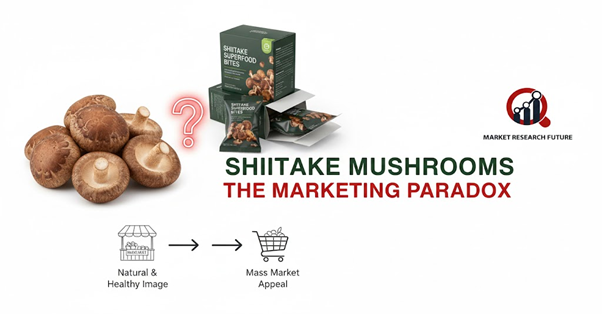Shiitake Mushrooms: The Marketing Paradox

The Shiitake Mushroom Market Insights
The rising preference for healthy diet encourages consumers toward the adoption of shiitake mushrooms in their meals. This trend upheld the size shiitake mushroom market to USD 790 million in 2024, which is projected to reach USD 1400 million by 2035. This propagation of the industry will adhere to a moderate CAGR of 5.39% through 2035.
The world is a dynamic place, and one of the most dramatic changes in our food system has been the rise of mushroom cultivation. Certainly, you’ve seen mushrooms on top of pizza, but they are also being used as ingredients in dishes ranging from pasta and burgers to desserts.
Mushrooms grow very quickly and require little care or processing before they are ready to be sold at market, which is likely why an industry once focused mainly on fresh mushrooms now includes shiitake mushrooms, oyster mushrooms, enoki mushrooms, Lion’s Mane (also called Yamabushitake), and more.
Shiitake mushrooms (Lentinula edodes) are among the most popular gourmet and medicinal mushrooms grown in the United States and worldwide. The shiitake mushroom is especially versatile because it is commonly consumed fresh, dried, and cooked. It can also be processed into powder form or used as an extract.
The Challenge of Growing Shiitake Mushrooms
As with any crop, there are many challenges to growing high-quality shiitake mushrooms. The biggest challenges include harvesting high-quality caps, producing a consistent supply of flushes, and keeping yields at a profitable level.
Unfortunately, there are challenges within this industry. Shiitake mushrooms can only be grown successfully during the fall because they require cooler temperatures than other mushrooms.
In spring, the temperature is often too warm, and if it is too cold, the plants die. There is also a low yield during the growing process, and people need training to cultivate shiitake mushrooms effectively.
Shiitake mushrooms cannot be grown commercially at home because they do not produce enough concentrated nutrients, and production levels are very low.
To overcome these challenges, new technological developments are needed to increase production levels and support marketing strategies that will enable producers to expand their businesses.
It is most difficult for shiitake mushroom producers to sell their products in international markets because there are limited resources at home to support this new market. In many cases, the business is managed by a single individual who grows shiitake mushrooms independently without broader infrastructure support.
Regional Analysis
Shiitake mushroom markets in Asia and Europe have increased because of their excellent taste, potential health benefits, and reasonable price. The market for shiitake mushrooms is expected to grow significantly over the next few years due to its affordable price and growing demand from people who want to try new foods.
Shiitake mushrooms are grown mainly in Asian countries such as China, Japan, and Korea, but exporting them requires significant support from local companies.
In Asia, however, it is especially difficult to find enough time during the fall season when it is not too hot or too cold for the mushroom plants to grow quickly without being damaged by extreme temperatures.
Europe represents a growing market, driven by gourmet and health-conscious consumers in countries such as Germany, France, and Italy. North America shows increasing demand for shiitake mushrooms in restaurants, specialty stores, and health-focused retail, though production is still limited compared to Asia.
Latin America and the Middle East present emerging markets with potential for growth, but challenges such as infrastructure and technical expertise may slow expansion.
Overall, regional factors including climate, cultivation expertise, and market access play a critical role in shaping the global shiitake mushroom market, making targeted regional strategies essential for producers seeking growth.

Leave a Comment